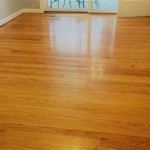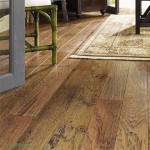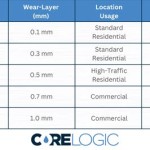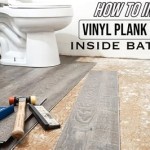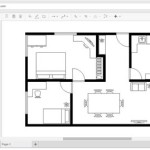Vinyl Flooring in Kitchens: Weighing the Pros and Cons
Vinyl flooring has become a popular choice for kitchens due to its affordability, durability, and aesthetic versatility. However, like any flooring material, it has both advantages and disadvantages that should be carefully considered before making a decision. This article explores these pros and cons, providing a comprehensive overview to help homeowners determine if vinyl flooring is the right option for their kitchen.
Vinyl flooring is a synthetic material composed primarily of polyvinyl chloride (PVC). It is manufactured in a variety of formats, including sheets, tiles, and planks, each offering different installation methods and design options. The top layer of vinyl flooring typically features a protective wear layer that resists scratches, stains, and wear and tear. Beneath the wear layer is a printed design layer, allowing for a wide range of patterns and colors, often mimicking the appearance of natural materials such as wood, stone, or tile. The core layer provides stability and cushioning, and some types include a backing layer for added comfort and sound absorption.
Key Advantages of Vinyl Flooring in Kitchens
Several factors contribute to the popularity of vinyl flooring for kitchen applications. These advantages relate to its cost-effectiveness, durability, ease of maintenance, and design flexibility.
Affordability: One of the most significant benefits of vinyl flooring is its relatively low cost compared to other flooring options like hardwood, tile, or stone. The lower material costs, coupled with potentially simpler installation, make vinyl an attractive option for budget-conscious homeowners. The price per square foot varies depending on the type and quality of vinyl, but it generally remains more economical than many alternatives. This makes it a viable option for larger kitchen areas where covering a significant surface can quickly become expensive with other materials.
Durability and Water Resistance: Kitchens are high-traffic areas prone to spills and moisture. Vinyl flooring excels in these conditions due to its inherent water resistance. Unlike hardwood, which can warp and rot when exposed to water, vinyl is virtually impervious. This makes it ideal for kitchens where spills from cooking, cleaning, and dishwashing are common. The wear layer also provides significant protection against scratches, dents, and scuffs, ensuring the flooring maintains its appearance over time. High-quality vinyl flooring can withstand years of heavy use without showing significant wear.
Ease of Maintenance: Maintaining vinyl flooring is straightforward and requires minimal effort. Regular sweeping or vacuuming removes loose debris, and occasional mopping with a mild detergent is sufficient to keep it clean. Unlike tile, which requires grout cleaning, or hardwood, which requires special cleaning products and precautions, vinyl is relatively low-maintenance. Its resistance to stains and spills further simplifies cleaning, as most messes can be easily wiped away without leaving permanent marks. This ease of maintenance is a significant advantage for busy households.
Design Versatility: Vinyl flooring is available in an extensive range of colors, patterns, and styles. Modern printing technology allows vinyl to realistically mimic the appearance of natural materials, such as wood, stone, and ceramic tile. This allows homeowners to achieve the desired aesthetic without the higher cost and maintenance requirements of these materials. Vinyl planks can replicate the look of hardwood flooring, complete with realistic grain patterns and textures. Vinyl tiles can mimic the appearance of stone or ceramic, offering a wide variety of color and size options. This versatility makes it easy to coordinate vinyl flooring with any kitchen design style, from traditional to contemporary.
Comfort and Noise Reduction: Compared to hard surfaces like tile or concrete, vinyl flooring offers a more comfortable underfoot feel. Some types of vinyl flooring incorporate a cushioned backing layer that provides added comfort and reduces noise transmission. This can be particularly beneficial in kitchens where people spend a lot of time standing or walking. The cushioned layer helps absorb impact and reduces the strain on joints and muscles. The noise reduction properties can also help create a quieter and more pleasant kitchen environment, reducing the sound of footsteps and dropped objects.
Potential Drawbacks of Vinyl Flooring in Kitchens
While vinyl flooring offers numerous advantages, it also has certain drawbacks that should be considered before installation. These include potential issues with indentations, repair difficulties, environmental concerns, and limitations in resale value.
Susceptibility to Indentations: While vinyl is generally durable, it can be susceptible to indentations from heavy furniture or appliances. Sharp objects or concentrated weight can leave permanent marks on the surface. To mitigate this, it is advisable to use furniture pads under heavy items and avoid dragging heavy objects across the floor. While some higher-quality vinyl flooring offers increased resistance to indentations, it remains a potential concern, particularly in kitchens where appliances and furniture are frequently moved or rearranged.
Repair Challenges: Damage to vinyl flooring, such as tears or cuts, can be difficult to repair seamlessly. While minor scratches and scuffs can sometimes be addressed with specialized cleaning products or repair kits, more significant damage often requires replacing the affected section. Matching the existing flooring color and pattern can be challenging, especially if the flooring has faded or been discontinued. Sheet vinyl, in particular, can be difficult to replace in sections, often requiring the replacement of the entire sheet. This can be a significant inconvenience and expense compared to repairing individual tiles or planks.
Environmental Concerns: Vinyl flooring is made from PVC, a plastic material that has raised environmental concerns. The production of PVC involves the use of chlorine, which can release harmful chemicals into the environment. Additionally, the disposal of vinyl flooring can be problematic, as it is not biodegradable and can release toxins when burned. However, some manufacturers are now offering more environmentally friendly vinyl flooring options made from recycled materials or with lower VOC (volatile organic compound) emissions. Consumers concerned about the environmental impact of vinyl flooring should research these options and consider alternative flooring materials.
Potential for Color Fading: Prolonged exposure to direct sunlight can cause vinyl flooring to fade or discolor over time. This is particularly true for darker colors and patterned designs. To minimize fading, it is advisable to use window coverings such as blinds or curtains to shield the flooring from direct sunlight. The rate of fading depends on the quality of the vinyl and the intensity of the sunlight exposure. While some higher-quality vinyl flooring is treated with UV inhibitors to reduce fading, it remains a potential concern, especially in kitchens with large windows that receive a lot of sunlight.
Resale Value Considerations: While vinyl flooring offers many practical benefits, it may not be perceived as a high-end flooring option by potential homebuyers. In some cases, installing vinyl flooring may not add as much value to a home as installing natural materials like hardwood or stone. While the aesthetic appeal of vinyl has improved significantly in recent years, some buyers may still prefer more traditional or luxurious flooring options. However, the affordability and durability of vinyl can be attractive to some buyers, especially those looking for a low-maintenance and cost-effective flooring solution. The impact of vinyl flooring on resale value depends on various factors, including the overall quality of the home, the local real estate market, and the preferences of potential buyers.
Different Types of Vinyl Flooring for Kitchens
The market offers several types of vinyl flooring, each with its own characteristics and suitability for kitchen environments. Understanding these differences is crucial for making an informed decision.
Sheet Vinyl: Sheet vinyl is a large, continuous piece of flooring that is installed in a single sheet, minimizing seams and creating a watertight surface. This makes it an excellent option for kitchens where water resistance is a priority. Sheet vinyl is typically less expensive than other types of vinyl flooring, but it can be more difficult to install, especially in larger or irregularly shaped kitchens. Professional installation is often recommended to ensure a smooth and seamless finish. The primary advantage of sheet vinyl is its ability to prevent water from seeping beneath the flooring, protecting the subfloor from damage.
Vinyl Tile: Vinyl tiles are individual pieces of flooring that are installed one at a time, allowing for greater design flexibility. They are available in a variety of shapes, sizes, and patterns, making it easy to create custom designs and borders. Vinyl tiles are generally easier to install than sheet vinyl, making them a suitable option for DIY projects. Damaged tiles can be easily replaced without having to replace the entire floor. However, the seams between tiles can be susceptible to moisture penetration if not properly sealed. Regular maintenance and resealing may be required to prevent water damage.
Vinyl Plank: Vinyl planks are designed to mimic the appearance of hardwood flooring. They are available in long, narrow strips that are installed side by side, creating a realistic wood-look floor. Vinyl planks are typically more durable and water-resistant than traditional hardwood flooring, making them a practical choice for kitchens. They are available in various thicknesses and wear layer options, allowing homeowners to choose the level of protection that meets their needs. Vinyl planks can be installed using a variety of methods, including glue-down, click-lock, and loose-lay. The click-lock method is particularly popular for DIY installations, as it requires no glue or nails.
Luxury Vinyl Tile (LVT) and Luxury Vinyl Plank (LVP): Luxury vinyl tile (LVT) and luxury vinyl plank (LVP) are premium versions of vinyl tile and plank flooring. They are typically thicker and more durable than standard vinyl flooring, with a more realistic appearance and texture. LVT and LVP often feature embossed surfaces that mimic the grain patterns of wood or the texture of stone. They are also more resistant to scratches, dents, and stains, making them a long-lasting and low-maintenance flooring option. LVT and LVP are generally more expensive than standard vinyl flooring, but they offer a higher level of quality and aesthetic appeal.

The Risks And Disadvantages Of Vinyl Flooring City Floor Supply Blog

Pros And Cons Of 5 Popular Kitchen Flooring Materials

10 Pros And 6 Cons Of Luxury Vinyl Flooring In Kitchens Direct Blog

Vinyl Flooring Pros And Cons Forbes Home

The Benefits Of Vinyl Kitchen Flooring Builddirect

Pros Cons Of Vinyl Flooring Eric Wright Carpets

The Pros And Cons Of Kitchen Vinyl Flooring

Hardwood Vs Luxury Vinyl Plank Flooring The Creative Kitchen Co
%2022340_BarnhouseOak_Weathervane_RS-23.jpg?strip=all)
Luxury Vinyl Flooring Pros Cons America

Luxury Vinyl Flooring Pros And Cons
